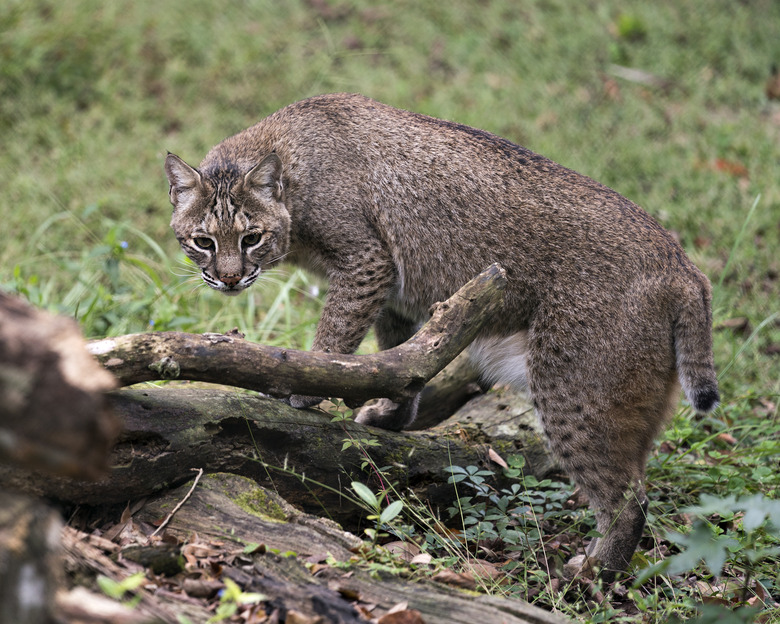Information On Bobcats For Kids
Bobcats (Lynx rufus) are animals in the cat (Felidae) family. Bobcats live across North America from northern Mexico to Canada.
They can be found living in forests, swamplands, deserts, scrublands and human inhabited areas. Bobcats are stealthy, nocturnal creatures, so humans rarely see them.
Fun Facts About Bobcats
Fun Facts About Bobcats
While most cats have long tails, bobcats' tails are short, which is where their name comes from as it appears to be cut, like a bob. Bobcats have iconic tufted ears and fur that ranges from grey to various shades of yellowish or reddish brown.
All bobcats have black spots, but the number of spots changes. Some have spots only on their legs and tummy while others are covered in them.
Male and female bobcats typically only interact when they are breeding. The territories of males can cover an area of 25 to 30 square miles (40 to 48 square kilometers) and overlap with other female and male bobcats, but smaller females territories of 5 square miles (8 square kilometers) don't tend to merge. Like house cats, bobcats can make hissing, purring, snarling, calling and growling noises.
Diet Bobcat Information for Kids
Diet Bobcat Information for Kids
**Bobcats, like all cats, are obligate carnivores** meaning they need to eat meat to survive. When hunting, they use their stealth to stalk prey and then pounce to kill them.
Bobcats can catch prey larger than themselves such as deer. However, bobcats typically eat smaller prey like rabbits, mice, squirrels, beavers, lizards, snakes, fish, birds and bats.
Adult Bobcat Facts
Adult Bobcat Facts
As adults, bobcats live alone, except when a mother has her cubs. Adults are roughly twice the size of an average house cat with a body length between 20 and 50 inches long (50.8 to 127 centimeters). Fully grown adults typically weigh between 15 and 30 pounds (6.8 to 13.6 kilograms). Wild bobcats live between 13 and 15 years old while captive bobcats can live up to 20 years old.
Adult bobcats will find hollow logs, caves, rock shelters, low hanging branches or boulders to form their dens. Bobcats have a main den, called the natal den and many auxiliary dens called shelter dens in their territory. They may move dens as often as once a day.
Baby Bobcat Facts
Baby Bobcat Facts
A mother bobcat is pregnant with her babies for 50 to 70 days before they are born. The mother will give birth to between one and eight kittens, but a litter usually has three or four kittens. Baby bobcats have their eyes closed until they are six days old. When they are born they weigh between 9.75 and 12 ounces (255 to 340 grams), about half the weight of a block of butter.
Baby bobcats are weaned off their mother's milk between three to four months old but continue to live in the den with their mothers until they are nine or twelve months old. Mothers start to teach their babies how to hunt when they are five months old. A mother bobcat will move her kittens around the different dens in her territory.
Important Bobcat Facts for Kids
Important Bobcat Facts for Kids
Bobcats are prey for larger carnivores such as:
- wolves
- mountain lions
- coyotes
- owls
- foxes
- humans
Bobcat populations are deemed to be of least concern by the IUCN Redlist. However, **they are still at risk of illegal hunting and habitat destruction. **
References
- Desert Museum; Animal Fact Sheet: Bobcat
- National Geographic: Bobcat
- ITIS Report: Lynx Rufus
- Veterinary Sciences: Cats and Carbohydrates: The Carnivore Fantasy?
- IUCN Redlist: Lynx Rufus
- Big Cat Rescue: State Laws For Keeping Exotic Cats
- National Geographic: Exotic Pet Trade, Explained
- Defenders of Wildlife: Basic Facts About Bobcats
Cite This Article
MLA
Jerrett, Adrianne. "Information On Bobcats For Kids" sciencing.com, https://www.sciencing.com/information-bobcats-kids-8681431/. 22 November 2019.
APA
Jerrett, Adrianne. (2019, November 22). Information On Bobcats For Kids. sciencing.com. Retrieved from https://www.sciencing.com/information-bobcats-kids-8681431/
Chicago
Jerrett, Adrianne. Information On Bobcats For Kids last modified March 24, 2022. https://www.sciencing.com/information-bobcats-kids-8681431/
